What do you think?
Rate this book


368 pages, Paperback
First published January 1, 2002

The first time I wrote this book—in 1996, when I was in my mid-twenties—I was angry: angry about my job, about the state of my country, about the callousness, complacency, and corruption that had dragged it there.If what she writes is anywhere near "the state of my country, about the callousness, complacency, and corruption that had dragged it there" (and I think it was), she had a right to be angry. The anger comes through. It makes me angry to think such conditions exist. We have a small, but distinct, filipino community in my town. They are good, hard-working people, and a close knit community. Most of them send money home to the Philippines every month, supporting not only family here but helping to support family "back home". I'm sure it is appreciated.
The second time I wrote this book—in 2013, in my forties, having moved back home with my infant son—I found myself even angrier: about the state of my country, which seemed even worse than it was in 1996, and about the callousness, complacency, and corruption that kept it there.
“The first time I wrote this book—in 1996, when I was in my mid-twenties—I was angry: angry about my job, about the state of my country, about the callousness, complacency, and corruption that had dragged it there.
The second time I wrote this book—in 2013, in my forties, having moved back home with my infant son—I found myself even angrier: about the state of my country, which seemed even worse than it was in 1996, and about the callousness, complacency and corruption that kept it there.”
— F. H. Batacan, Acknowledgments